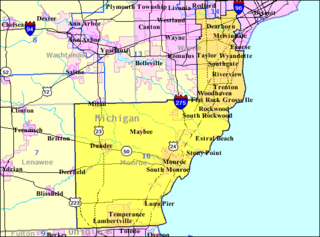| South Dakota's 2nd congressional district | |
|---|---|
| Obsolete district | |
| Created | 1910 |
| Eliminated | 1980 |
| Years active | 1913–1983 |
South Dakota's 2nd congressional district is an obsolete district. It was created after the 1910 census and was eliminated as a result of the redistricting cycle after the 1980 census. Members were elected at-large until the formation of individual districts after the 1910 census. From 1913 until 1933, it covered much of northeastern South Dakota, including the cities of Aberdeen, Brookings, Huron, and Watertown. [1] When South Dakota's 3rd congressional district was eliminated after the 1930 census, the 2nd district was relocated to cover all of the counties in South Dakota west of the Missouri River. [2] Population changes eventually moved its boundaries further east. During the 97th Congress, it covered all but the 21 easternmost counties in the state. [3]
The 20th congressional district of Ohio was created after the 1840 census. It was eliminated in the redistricting following the 1990 census, and redistricted and renumbered as the 10th district.
Ohio's at-large congressional district existed from 1803 to 1813, from 1913 to 1915, from 1933 to 1953 and from 1963 until 1967, when it was banned by the Voting Rights Act of 1965.

North Dakota's at-large congressional district is the sole congressional district for the state of North Dakota. Based on size, it is the eighth largest congressional district in the nation.
North Dakota's 1st congressional district is an obsolete congressional district in the state of North Dakota that existed from 1913 to 1933, and from 1963 to 1973.

South Dakota's at-large congressional district is the sole congressional district for the state of South Dakota. Based on area, it is the fourth largest congressional district in the nation.
South Dakota's 3rd congressional district is an obsolete United States congressional district. It was created after the 1910 census and abolished after the 1930 census. The district covered all of the counties in South Dakota west of the Missouri River.
South Dakota's 1st congressional district is an obsolete congressional district that existed from 1913 to 1983.
The 40th congressional district of New York was a congressional district for the United States House of Representatives in New York. It was created in 1913 as a result of the 1910 census. It was eliminated in 1973 as a result of the 1970 redistricting cycle after the 1970 United States census. It was last represented by Henry P. Smith III who was redistricted into the 36th district.
The 41st congressional district of New York was a congressional district for the United States House of Representatives in New York. It was created in 1913 as a result of the 1910 census. It was eliminated in 1973 as a result of the 1970 redistricting cycle after the 1970 United States census. It was last represented by Thaddeus J. Dulski who was redistricted into the 37th district.
Pennsylvania's 31st congressional district was one of Pennsylvania's districts of the United States House of Representatives. It existed from 1903 to 1953.

Massachusetts's 16th congressional district is an obsolete district. It was first active 1803–1821 in the District of Maine and again active 1913–1933 in the Cape Cod region. It was eliminated in 1933 after the 1930 census. Its last congressman was Charles L. Gifford, who was redistricted into the 15th district.

Massachusetts's 15th congressional district is an obsolete district that was first active 1803–1821 in the District of Maine, and again active 1913–1943 in Southeastern Massachusetts. It was last eliminated in 1943 after the 1940 census. Its last congressman was Charles L. Gifford, who was redistricted into the ninth district.

Michigan's 16th congressional district is an obsolete United States congressional district in Michigan. It covered the communities of Dearborn, Downriver and Monroe County.

Montana's 1st congressional district is a congressional district in the United States House of Representatives that was apportioned after the 2020 United States census. The first candidates ran in the 2022 elections for a seat in the 118th United States Congress.
Alabama's 8th congressional district, now obsolete, was established in 1877.
North Dakota's 2nd congressional district is an obsolete congressional district in the state of North Dakota that was created by reapportionments in 1913, and eliminated by the reapportionments in 1933. North Dakota elected its two Representatives in a two-member at large district from 1932 to 1960, but then resurrected single-member districts in 1962. The district was eliminated by the reapportionment as a result of the 1970 redistricting cycle after the 1970 United States census. The seat was last filled from 1971 to 1973 by Arthur A. Link, who sought the office of Governor of North Dakota after not being able to run again for the defunct seat.
North Dakota's 3rd congressional district is an obsolete congressional district in the state of North Dakota that was created by reapportionments in 1913, and eliminated by the reapportionments of the 1930 census in 1933. The district consisted of the western part of the state, and was made up of following counties: Divide, Burke, Renville, Ward, Mountrail, Williams, McKenzie, McLean, Dunn, Mercer, Oliver, Billings, Stark, Morton, Hettinger, Bowman and Adams.
Rhode Island's 3rd congressional district is an obsolete district. It had a short tenure (1913–1933). In its final configuration, it covered Providence and most of its inner ring suburbs. It was eliminated after the 1930 census and split between the 1st and 2nd districts. The 3rd's last representative, Francis Condon subsequently won re-election in the 1st district.
Pennsylvania's 22nd congressional district was one of Pennsylvania's districts of the United States House of Representatives.
Pennsylvania's 24th congressional district was one of Pennsylvania's districts of the United States House of Representatives.